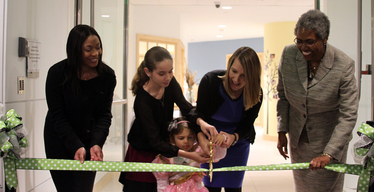 Left to Right...Julia Hudson (GSA-RA), (teen) former student of Diplotots One, Current Preschooler, Heather Higginbottom (Deputy Secretary-Department of State), Joyce Barr (Assistant Secretary-Department of State)
The State Department capped off Work and Family month with a ribbon cutting event at their newest child care center, “Diplotots Too” in Washington, DC. On October 31st, Department of State Deputy Secretary Higginbottom joined GSA Regional Administrator Julia Hudson and other State Department officials in celebrating the latest center to join the GSA network. This center originally built in the ‘80s for the World Bank was transformed to care for 108 children, infant through prek. In real sustainable fashion the new center has maintained and reused some of the original Reggio inspired fixtures and woodwork while updating the space to include an internal stair case, new kitchen and dumbwaiter, and fabulous outdoor play yard. Many thanks to Darlene Daniels and Ania Shapiro, GSA child care staff, for working tirelessly to get the center ready to open. Continued thanks to Annie Cocchiaro, Board President, for her many years of service, not to mention her cake baking skills!
 |
Reusing original wood finishes

GSA Child Care Centers undergo regular lead and copper in water testing. This month testing will be performed in Regions 3 and 11 (DC, MD, PA VA & WV). GSA uses EPA protocols to test for lead and copper, which are natural metals commonly found in plumbing.
Providing a healthy environment is critical in shaping children’s future health and development. One important way GSA Child Care Centers protect children is by taking steps to reduce potential exposure from lead.
GSA Child Care Centers use Eco-Healthy Child Care Program (EHCC) standards to make child care centers more environmentally friendly by reducing toxins in the facilities and implementing eco-healthy practices. EHCC explains children can be exposed to lead by:
- ingestion
- food, beverages and water*
- soil and dust
- inhalation- aerosols can be harmful. Wipes are preferred.
- skin absorption
- prenatal exposure
*use only cold water for drinking, cooking and heating bottles because hot water activates lead levels. And flush (by running the water) all cooking and drinking outlets after long periods of non-use.
See EHCC standards #11-15 for more ways to protect children from lead exposure. Visit: http://www.cehn.org/ehcc
The CDC states, “Protecting children from exposure to lead is important to lifelong good health. No safe blood lead level in children has been identified. Even low levels of lead in blood have been shown to affect IQ, ability to pay attention, and academic achievement. And effects of lead exposure cannot be corrected. The goal is to prevent lead exposure to children before they are harmed. There are many ways parents can reduce a child’s exposure to lead. The most important is stopping children from coming into contact with lead. Lead hazards in a child’s environment must be identified and controlled or removed safely.”
For more lead prevention tips visit http://www.cdc.gov/nceh/lead/tips.htm
|
Region 10

The Green Tree Child Care Center in Seattle, WA, along with all building tenants and over 25 million people globally, took cover on October 16, 2014 for The Great Shakeout earthquake preparedness drill. In addition to monthly fire drills, Green Tree has stepped up their practice to include earthquake drills. Teachers use everyday learning opportunities to encourage children to take a safe place under the tables in the classrooms. The teachers provided a signal, which directed the children to find their safe spot. The children were well-prepared and successfully met the Great Shakeout challenge.
|
It's CFC Time!
It's that time of year again! The CFC 2015 Campaign season runs through December 15, 2014. Last year 33% of GSA Child Care Centers received CFC funds and the average yearly donation to each center was almost $8,000.
If your center is a CFC charity this is a reminder to MARKET YOUR CENTER AND CFC NUMBER! Make sure your federal parents and federal community know your number and their ability to donate to you! Get the word out through email lists, bulletin boards, newsletters and social media. Let your community know the center will use the funds for tuition assistance in your local area. Let them know that every donation counts no matter how large or small. For example, a donation of only $10 a pay period in 2015 means your child care center will get $260 for the year to help families pay for child care or to enrich your program. Up that donation to $25 per pay period and that raises the capacity of your dollars to $650. The process is easier than ever now that donations can be made on-line.
If you are not currently a CFC Charity there is no time like the present to get started. Charities can find contact information for local CFC offices via the OPM Campaign Locator (http://www.opm.gov/cfc/Search/Locator.asp). See the application instructions for more information.
Each local campaign sets its own deadline, so get going!
For more information about CFC check out their website, www.cfctoday.org.
|